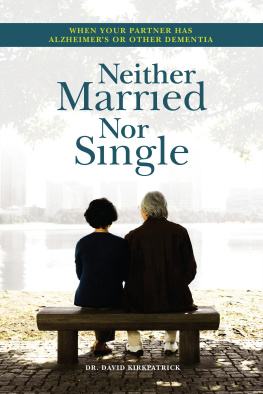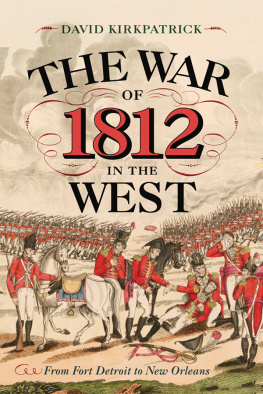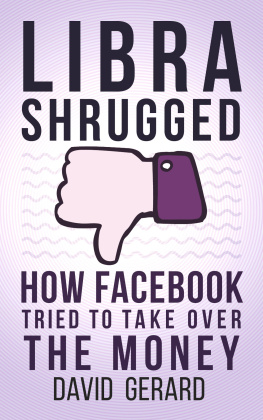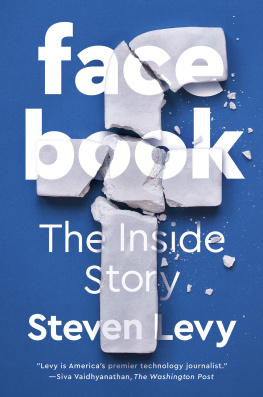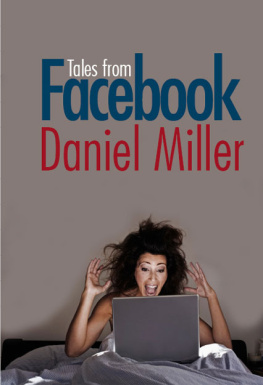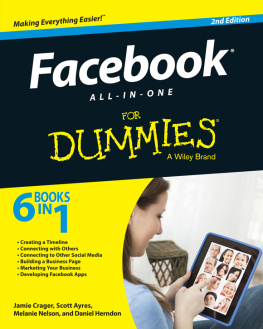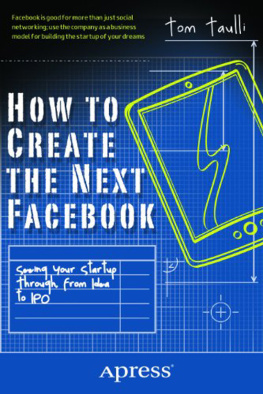
the
facebook
effect
The Inside Story of the Company
That Is Connecting the World
David Kirkpatrick


Simon & Schuster
1230 Avenue of the Americas
New York, NY 10020
www.SimonandSchuster.com.
Copyright 2010 by David Kirkpatrick
All rights reserved, including the right to reproduce this book or
portions thereof in any form whatsoever. For information address
Simon & Schuster Subsidiary Rights Department,
1230 Avenue of the Americas, New York, NY 10020
First Simon & Schuster hardcover edition June 2010
SIMON & SCHUSTER and colophon are registered trademarks
of Simon & Schuster, Inc.
For information about special discounts for bulk purchases,
please contact Simon & Schuster Special Sales at
1-866-506-1949 or business@simonandschuster.com.
The Simon & Schuster Speakers Bureau can bring authors to your live event. For more information or to book an event contact the Simon & Schuster Speakers Bureau at 1-866-248-3049 or visit our website at www.Simonspeakers.com.
Designed by Nancy Singer
Manufactured in the United States of America
10 9 8 7 6 5 4 3 2 1
Library of Congress Cataloging-in-Publication Data
Kirkpatrick, David, date.
The Facebook effect : the inside story of the company that is connecting the world / David Kirkpatrick.
p. cm.
Includes bibliographical references and index.
1. Facebook (Firm) 2. Internet industryUnited States. 3. Online social networksHistory. I. Title.
HD9696.8.U64F335 2010
338.7'61006754dc22 2009051983
ISBN 978-1-4391-0211-4
ISBN 978-1-4391-0980-9 (ebook)
To Elena and Clara
Contents
the
facebook
effect
Prologue The Facebook Effect
Oscar Morales was fed up. It was holiday time in his hometown of Barranquilla, Colombia, just after the 2008 new year. The gentle-spirited civil engineer with a gift for computers was spending his days at the bucolic nearby beaches with his extended family. But despite the holidays, like much of the country his thoughts were dark, and occupied with the suffering of a little boy named Emmanuel.
Emmanuel was the four-year-old son of Clara Rojas, who had been a hostage in the jungles of Colombia for six years. Her son had been born while she was held by the guerrillas of the Revolutionary Armed Forces of Colombia, known by its Spanish initials, FARC. FARC held a total of seven hundred hostages, including Colombian presidential candidate Ingrid Betancourt, kidnapped along with Rojas during the 2002 campaign.
Sympathy and sadness about the plight of FARCs hostages was an ever-present fact in contemporary Colombia, as was fear about what the powerful and murderous revolutionary army might do next to disrupt the country. But the case of Emmanuel had lately acquired outsized prominence in the popular press. For some time President Hugo Chavez of neighboring Venezuela had been attempting to negotiate with FARC about releasing Betancourt and others. that they would soon turn over Rojas, her son Emmanuel, and another hostage to Chavez. In a nation exhausted from a decades-long battle with the violent guerrillas, this was a rare piece of good news. People were longing for a gift, for a miracle, says Morales, thirty-two. And Emmanuel was a symbol. The whole country was feeling the promise: Please let Emmanuel get his freedom. We would like that as a Christmas present from FARC.
But as the new year arrived, Emmanuel still hadnt been freed. Then, in the first days of January, Colombian president Alvaro Uribe went on national television to deliver the shocking news that it appeared that Emmanuel was not even in the possession of FARC! It turned out Emmanuel had become seriously ill some time earlier, and FARC had taken him away from his mother, Clara, and dumped him with a peasant family. He was now, unexpectedly, in the governments hands.
The nation was still on holiday with plenty of time to watch the news, which was all about poor, sick, abandoned Emmanuel. Moraless politically engaged extended family, hanging out by day at the beach, debated what might happen next. People were happy because the kid was safe, but we were so fucking angry, Morales says. Forgive me for using that word but we felt assaulted by FARC. How could they dare negotiate for the life of a kid they didnt even have? People felt this was too much. How much longer was FARC going to play with us and lie to us?
Morales wanted desperately to do something. So he turned to Facebook. Though the service wasnt yet even translated into Spanish, Morales spoke fluent English, as do many educated Colombians, and had been maintaining a profile there for over a year, posting his own information in Spanish and connecting with old college and high school friends. Spending time on Facebook was already a daily ritual for him.
In Facebooks search box he typed the four letters FARC and hit enter. There were no results. No groups. No activism. No outrage. Groups devoted to almost everything under the sun were common on Facebook. But when it came to FARC, the citizens of Colombia had become used to being angry but cowed. In effect, the entire country had been taken hostage, and this had been going on for decades.
Morales spent a day asking himself if he was willing to go public on Facebook. He decided to take the plunge, and on the 4th created a group against FARC. It was like a therapy, he says. I had to express my anger. He wrote a short description of the groups simple purposeto stand up against FARC. A self-confessed computer addict, Morales was skilled at graphics tools, so he designed a logo in the form of a vertical version of the Colombian flag. He overlaid it with four simple pleas in capitals running down the page, each one slightly larger than the lastNO MORE KIDNAPPINGS, NO MORE LIES, NO MORE KILLINGS, NO MORE FARC. I was trying to scream like if I was in a crowd, he explains. The time had come to fight FARC. What had happened was unbearable.
But what should he call his group? On Facebook its conventional to give groups names like I bet I can find one million people who hate George Bush. But Morales didnt like such titles. They were juvenile. This was not a contest. This was serious. Yet he liked the idea of a million. A famous Spanish song is called One Million Friends. One million people against FARC? The word voices sounded more literary. One million voices against FARCUn Millon de Voces Contra Las FARC. That was it.
After midnight on January 4, Morales created the group. He made it public so that any Facebook member could join. His personal network included about one hundred friends, and he invited them all. He was tired. At 3 A.M. he went to bed.
At 9 A.M. the next morning he checked his group. Fifteen hundred people had joined already! Woooooooo!!! Morales howled in delight. This was an even better response than he had expected! That day at the beach he told his extended family about the group and asked them to invite their own Facebook friends to join. Most of them were avid Facebook users as well, and they hated FARC, too. By the time Morales returned home in the late afternoon, his group had four thousand members.
Thats when I said to myself, Okay, no more beach, no more going out. He was ready to get serious. I felt, Oh my God! This is what I want! A committed community around the message.
A Facebook group has a wall, where members can post thoughts, as well as discussion forums that allow organized, long-lasting conversations among many members. Morales soon bonded with several people who were posting there with special vigor. They exchanged instant messaging and Skype addresses and cell-phone numbers so they could continue their conversations offline.
Next page

